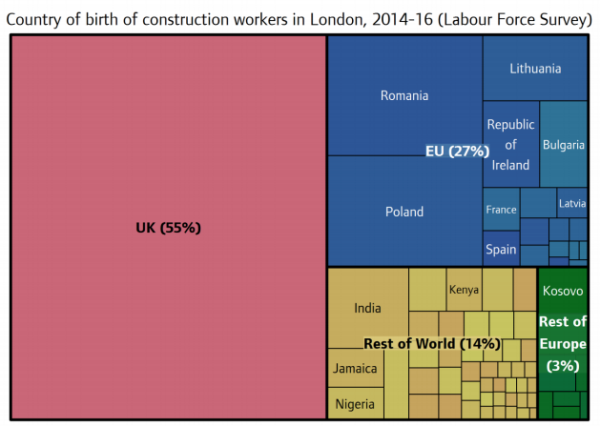
Fresh concerns raised over London’s construction workforce and housing
The Mayor of London, Sadiq Khan, has reiterated the importance of retaining access to a skilled workforce following Britain’s exit from the European Union, after new figures revealed that 95,000 of London’s construction workforce are from countries within the EU.
Published today, the Housing in London report found that of London’s 350,000 construction professionals, just over half are born in the UK, whilst 27 per cent are from the EU, three per cent is from other European countries and 14 per cent are from the rest of the world.
The report suggests than an additional 13,000 new workers will need to be recruited each year up to 2021 in order to meet additional demands on the construction industry.
Commenting on the report, Sadiq Khan said: “When I speak to businesses – both large and small – one of the biggest issues they raise with me is the skills gap. They tell me that maintaining a skilled workforce is absolutely crucial to their future and the future of the whole economy.
London is in the grip of a serious housing crisis – and fixing it is going to be a marathon, not a sprint. While we are working to train up more Londoners to have the skills to work in construction, you can’t escape the fact that a ‘Hard Brexit’ could leave a quarter of the skilled construction workforce in the capital high and dry which would have a crippling effect on our plans to build the homes Londoners so desperately need.”
Concerns over housing
The Housing in London report also revealed that Londoners’ concerns over housing is at its highest level on record, with 37 per cent of survey respondents citing housing supply as one of the biggest issues facing the UK.

Whilst there were 24,390 gross completions in 2015, it is still far off the levels of the 1930s and 1970s.
In 2015, housebuilding reached its highest level since 1978; however, the recent supply of housing has been low in historical terms. Over the last decade an average of 20,030 homes have been built each year, compared to an average of 61,460 in the 1930s and 29,420 in the 1970s.
In the past 20 years, the number of homes in the capital has only increased by 15 per cent, far behind the 25 per cent increase in population and 40 per cent rise in jobs.
Private rentals on the rise
The report highlighted the rapid growth of London’s private rental sector, which now accounts for more than two thirds of all housing moves, and is expected to match owner occupation by 2025.

Private rentals are projected to match owner occupied housing within the next eight years. Data compiled by GLA from ONS Census data and PwC regional tenure projections (Feb 2016).
The Housing in London report sets out the evidence base for the Mayor of London’s housing policies, summarising patterns and trends across a range of topics relevant to the capital’s housing industry. The report will inform the development of the London Housing Strategy, which will be published for consultation later in the year.
Latest news

29th April 2025
Senior pledges to ‘bee’ part of the solution with new biodiversity initiative
Senior Architectural Systems has installed its first on-site beehive, marking another step forward in its commitment to sustainability and biodiversity.
Posted in Articles, Building Industry News, Building Products & Structures, Building Services, Curtain Walling, Doors, Glass, Glazing, Innovations & New Products, news, Restoration & Refurbishment, Retrofit & Renovation, Sustainability & Energy Efficiency, Walls, Windows
29th April 2025
West Fraser range delivering key benefits for South-East carpentry company
An experienced carpenter and building site manager who has recently set up his own company is using high performance panel products from the West Fraser range.
Posted in Articles, Building Industry News, Building Products & Structures, Building Systems, Case Studies, Garden, Restoration & Refurbishment, Retrofit & Renovation, Sustainability & Energy Efficiency, Timber Buildings and Timber Products
29th April 2025
CPD Courses Available Online From Ecological Building Systems
Ecological Building Systems, a leading supplier of natural building products for sustainable construction, has revealed its comprehensive CPD programme for the year ahead.
Posted in Articles, Building Industry Events, Building Industry News, Building Products & Structures, Building Services, Continuing Professional Development (CPD's), Information Technology, Innovations & New Products, Insulation, Restoration & Refurbishment, Retrofit & Renovation, Seminars, Sustainability & Energy Efficiency, Training, Walls, Waste Management & Recycling
29th April 2025
WindowBASE launches new prospect databases at FIT Show
Visit WindowBASE at the FIT Show to see first-hand how it helps companies find new customers – the company is launching an easy-to-use, intuitive platform on Stand G16 at the NEC Birmingham from 29th April – 1st May.
Posted in Articles, Building Industry Events, Building Industry News, Building Products & Structures, Building Services, Doors, Exhibitions and Conferences, Glass, Glazing, Information Technology, Innovations & New Products, Posts, Publications, Research & Materials Testing, Restoration & Refurbishment, Retrofit & Renovation, Windows
 Sign up:
Sign up: 